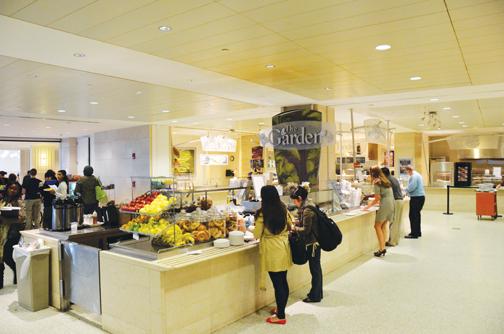Sodexo Inc., a provider of integrated food and management services in the U.S., Canada and Mexico, is responsible for UMB dining services. The majority of the food vendors and chefs on the UMB campus is managed by the Sodexo Inc. staff. The corporation works in conjunction with a variety of vendors including the University Club, The Atrium Café, Harbor Café, Pandini’s, It’s a Wrap, Sizzlin, Soup Sensations, Burger King and Southern Tsunami Sushi. Sodexo also supplies other schools in the region like Suffolk University, Babson College, Stonehill College, MIT and others.
The current contract that Sodexo has with UMB started in January 2004 and is due to run out in June 2013. The food corporation is looking to renew it. The parameters of the current contract require that the university receive 9.5 percent of every dollar spent in the dining as commission. The university in turn uses money to pay for the entire sustainability program. The university has just begun a Dining Services Review process in preparation for the public bidding process for a new contract, which will go out late next year.
According to David Levine, the general manager of Sodexo at UMB, the major determinant of the prices of UMB meals, is the cost of food. Seasonality, floods, heat, draught, and several other natural causes can affect the cost of food. Other factors like labor-benefits and competitive analysis are taken into consideration when fixing price. UMB’s branch of Burger King’s prices is currently below the average Burger King prices.
Sodexo Inc. is allowed to change prices once every year by contract every September. During that period Levine sits down with Diane D’Arrigo, the assistant vice chancellor for Campus Services, to discuss potential meal price changes and their respective reasons.
Students have rather opposing opinions about the prices and quality of the food served on campus. Freshman Chloé Danielson, a political science major, mostly buys her lunch off campus because she believes the food prices at UMB are a bit too high. She said, “I buy my food off campus mostly because the cafeteria prices hit my pocket too hard.”
Ted McCleary, who is a classics major, has a different view on the issue. “I get breakfast here almost every day because I think it’s a very good deal.”
D’Arrigo states that the food prices haven’t dropped recently due to the state of the economy, but the prices that do go up increase very minimally. The majority of the meal prices are stable over the years. D’Arrigo cited the example of the sushi sold in the food court which has remained at the same price for about two years. For the prices to go up, Sodexo representatives have to present strong justification to that effect like comparing the UMB dining prices to other schools in the region’s dining prices and the price of foodstuff in the global market. For
D’Arrigo also mentioned that UMB doesn’t subsidize dining at all except through the support of the inflation fighter meal. The inflation fighter meal is offered in Harbor Market in the Food Court every Wednesday for $2.99. She explained that the university uses some of the commission money collected from the Sodexo contract to support the subsidization of this lower cost meal one day per week.
While some students reduce spending, other students like Thalia Blanco, an undecided freshman, minimize spending even more by choosing the alternative of bringing home made lunches to school. When interviewed she said, “They’re too expensive and there’s no number 4 on the Burger King menu.”
Due the growing amount of students and the diversity that comes along with that, Levine and D’Arrigo both acknowledged that it would be quite challenging to please every student’s tastes buds, but insisted that the possible best is being done to satisfy the students’ wants by trying to strike a balance with the prices and tastes of the meals.
“We try to give quality products at a reasonable price that people will come back for,” said Levine and D’Arrigo echoed his desires saying, “We continue to work very hard to serve a wide range contingency and good things are happening here and we continue to work hard at improving the offerings and services provided.”





















































